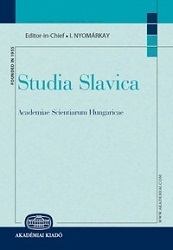Індоєвропейські витоки обрядовості слов’янського епосу
The Indo-European Origins of Rituals in Slavic Epics
Author(s): Nazarii A. NazarovSubject(s): Customs / Folklore, Ethnohistory, Ancient World, Sociolinguistics, Theory of Literature, Sociology of Religion, History of Religion
Published by: Akadémiai Kiadó
Keywords: Ukrainian; Slavic epics; Indo-European poetics; the language of folklore; rituals; paganism; epic formulas; duma; bylina;
Summary/Abstract: Was there a goddess Slava in Slavic pagan antiquity? Though there have been voices that it was possible, the analysis of Slavic folklore texts proved the issue to be more complex. The present paper shows that Ukrainian folklore as well as the folklore of other Slavic peoples may have preserved stable compositional clichés that can be traced back to Indo-European prototypes. In their turn, these clichés may be explained as the verbal reflections of ritual practices and sacred etiquette. It is stated that the final parts of Ukrainian dumas, Russian bylinas, and Serbian heroic songs that contain praise (slava) of natural forces can be regarded as remnants of pagan beliefs with strongly proved Indo-European background. The common motives of slava in different Slavic epic traditions give us important insights into the Slavic pagan religion. At the end of dumas, bylinas, and South Slavic heroic songs, there is a distinct part in which the singer, apart from the main story, blesses the audience and the universe. This part had preserved the composition scheme comparable to that of Old Indian stuti hymns, Pindaric, and Vedic poetry: 1) an invocation to the deity or a person with higher social rank; 2) a recounting of the previous (semi)mythological precedent; 3) a request. The obligatory lexical element of the final part of Slavic eposes is slava. As it is mentioned in the context of mourning over the dead or calming the natural forces, it is very likely that the concept was connected to the cult of ancestors and natural forces – one of the most archaic forms of religion. It is proved by two non-neighbouring cognate folklore sources. In Hutsul funerals up to the beginning of the 20th century, slava used to serve as a taboo name of the soul of the deceased. Meanwhile, at least up to 19th century, the Serbs preserved the holiday of slava that is interwoven with the cult of the dead (e.g., kolyvo was eaten during the rite). Thus, though we cannot claim the existence of the personified goddess named Slava, we have strong evidence about the notion of slava (praise, fame) that could have been current in Common Slavic religion. It is even more likely due to the underlying Indo-European tradition, in which the notion of fame was not personified though crucial for the ideology of warring elites (like in Pindar’s lyric). Such evasive notion of slava that was not always personified though praised comforts very well to the picture of ancient Slavic religion handed down to us by Procopius of Caesarea. He claimed that ancient Slavs praised natural forces, rivers, and forests. Likewise, in the fragments preserved in some of Ukrainian dumas and songs from Kirsha Danilov’s collection, the praise (slava) was sung not only to the heroes but also to rivers and fields.
Journal: Studia Slavica Academiae Scientiarum Hungaricae
- Issue Year: 64/2019
- Issue No: 1
- Page Range: 117-130
- Page Count: 14
- Language: Ukrainian
- Content File-PDF

